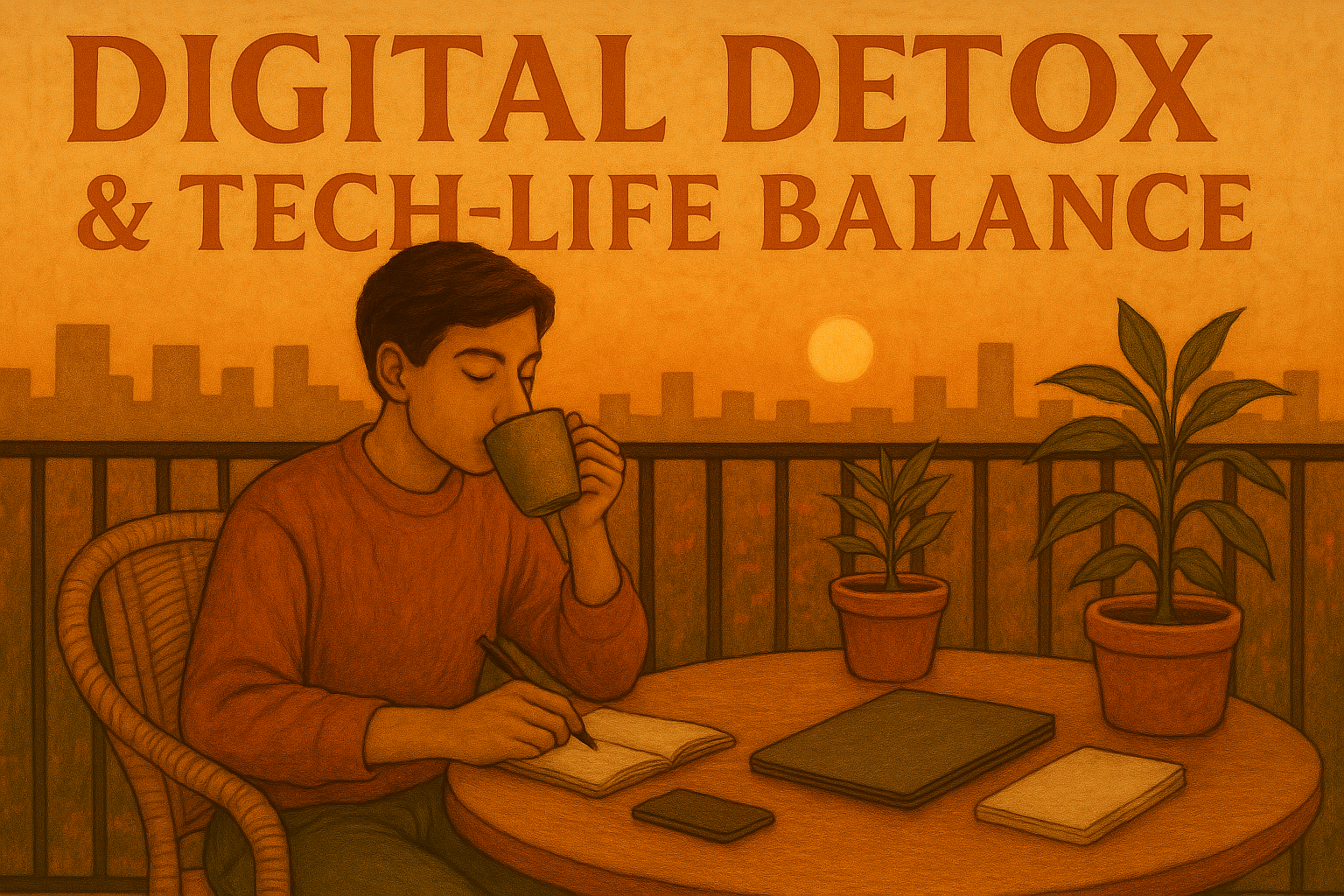Digital Detox & Tech-Life Balance: Reclaiming Your Time and Mind in 2025
Introduction: Why We Need a Digital Reset
In 2025, the average person spends over 8 hours a day on screens—scrolling, swiping, streaming, and working. While technology has revolutionized how we live, work, and connect, it’s also created a new kind of exhaustion: digital fatigue. Notifications never stop. Work follows us home. Social media blurs the line between connection and comparison.
Enter the concept of digital detox a conscious break from screens to restore mental clarity, emotional balance, and real-world presence. But this isn’t about ditching tech altogether. It’s about creating a tech-life balance that supports your well-being instead of draining it.
What Is a Digital Detox?
A digital detox is the intentional act of reducing or eliminating screen time especially from smartphones, computers, and social media for a set period. The goal is to reconnect with yourself, others, and the offline world.
Common Signs You Might Need a Detox:
- You check your phone within 5 minutes of waking up.
- You feel anxious when your battery is low.
- You scroll endlessly but feel unfulfilled.
- You struggle to focus without background noise or notifications.
- You sleep poorly due to late-night screen use.
If any of these sound familiar, it might be time to hit pause.
The Digital Landscape in 2025: Stats That Matter
- 72% of adults report feeling overwhelmed by screen time.
- Over 60% experience digital burnout symptoms like eye strain, anxiety, and poor sleep.
- Digital detox retreats have increased by 40% since 2023.
- Smartphone usage averages 4.8 hours per day, with social media accounting for nearly 3 hours.
These numbers highlight a growing need for intentional tech use and regular digital breaks.
The Benefits of a Digital Detox
1. Improved Mental Health
- Reduces anxiety, FOMO, and comparison fatigue.
- Promotes mindfulness and emotional regulation.
2. Better Sleep
- Less blue light exposure improves melatonin production and sleep quality.
3. Enhanced Focus and Productivity
- Fewer distractions = deeper work and creative flow.
4. Stronger Relationships
- More face-to-face interaction and meaningful conversations.
5. Physical Health Boost
- Less screen time means reduced eye strain, better posture, and more movement.
Real-World Example: Omar’s 7-Day Detox
Omar, a 29-year-old software engineer, felt constantly drained despite working from home. He committed to a 7-day digital detox no screens after 8 PM, no social media, and tech-free meals. By day three, he reported better sleep, more energy, and deeper conversations with his partner. He now practices a “Digital Sabbath” every Sunday.
How to Start a Digital Detox in 2025
1. Set Clear Goals
Decide what you want to achieve: better sleep, less stress, more time with family?
2. Start Small
Begin with 1–2 hours of screen-free time daily. Gradually build up to a full day or weekend.
3. Create No-Tech Zones
Designate areas like the bedroom, dining table, or bathroom as screen-free.
4. Turn Off Notifications
Disable non-essential alerts to reduce dopamine-driven distractions.
5. Use Tech to Detox from Tech
Apps like Forest, One Sec, and Opal help limit screen time and encourage mindful breaks.
Expert Insights
“Digital detoxing isn’t about rejecting technology it’s about using it with intention. Boundaries are the new self-care.” Dr. Leena Farooq, Digital Wellness Researcher
“Even 30 minutes of screen-free time before bed can improve sleep quality by 25%.” Dr. Marcus Lin, Sleep Specialist
Practical Hacks for Tech-Life Balance
- Schedule “phone-free” hours each day.
- Replace screen time with analog activities: reading, journaling, walking.
- Use grayscale mode on your phone to reduce visual stimulation.
- Try a dopamine detox: avoid all digital entertainment for 24 hours.
- Practice the 20-20-20 rule: every 20 minutes, look at something 20 feet away for 20 seconds.
Digital Detox Trends in 2025
| Trend | Description |
|---|---|
| Digital Sabbaths | One day a week completely offline popular among Gen Z and millennials. |
| Phone-Free Retreats | Wellness getaways that collect your devices at check-in. |
| Tech-Free Bedrooms | People are replacing phones with books and analog alarm clocks. |
| No-Email Fridays | Some companies now ban internal emails on Fridays to reduce burnout. |
| Mindful Tech Apps | Tools like Headspace, Forest, and One Sec promote intentional tech use. |
Case Study: The “Digital-Free Dinner” Movement
In 2025, restaurants in major cities like Tokyo, London, and New York are offering discounts for phone-free dining. Diners place their phones in a lockbox and enjoy uninterrupted meals. Surveys show that 92% of participants felt more connected to their companions during these meals.
Conclusion: Reclaiming Your Time and Mind
Technology is a powerful tool but without boundaries, it can become a burden. A digital detox isn’t about abandoning your devices. It’s about redefining your relationship with them. By creating space between you and your screens, you can rediscover focus, joy, and real-world connection.
In 2025, tech-life balance is no longer optional it’s essential. Start small. Stay consistent. Your mind, body, and relationships will thank you.
FAQ: Digital Detox & Tech-Life Balance
1. How long should a digital detox last? Start with 1–2 hours daily. Even a weekend detox can be impactful.
2. Is it okay to use tech for work during a detox? Yes. Focus on reducing non-essential screen time like social media or binge-watching.
3. What’s the best time to unplug? Evenings and mornings are ideal—avoid screens 1 hour before bed and after waking.
4. Can kids benefit from digital detoxes? Absolutely. Tech-free playtime improves creativity, focus, and emotional regulation.
5. Are there apps that help with digital detoxing? Yes! Try Forest, One Sec, Opal, or Digital Wellbeing (Android) and Screen Time (iOS).
6. What if I relapse during a detox? No worries. Detoxing is a practice, not perfection. Just restart and keep going.
7. Can digital detoxing improve productivity? Yes. Reduced distractions lead to better focus, deeper work, and less burnout.
